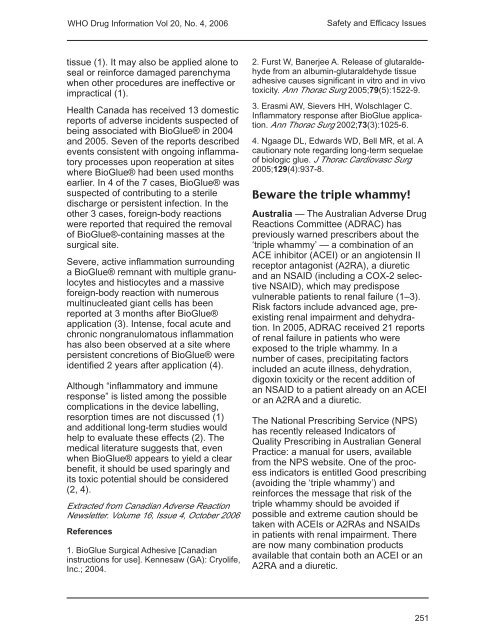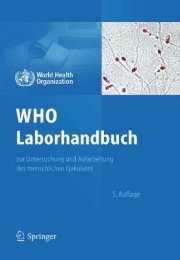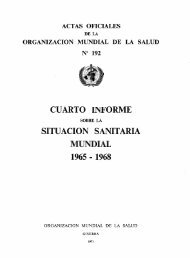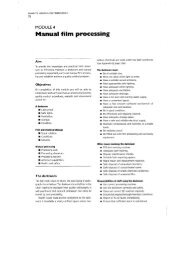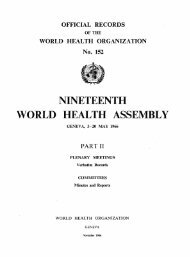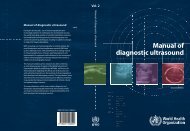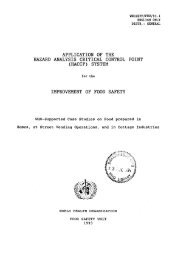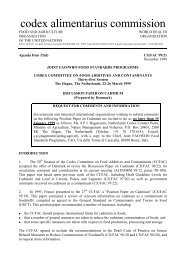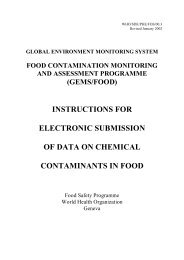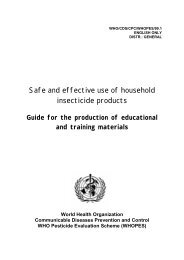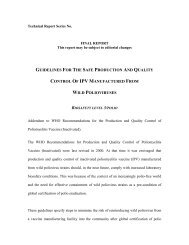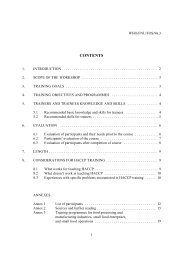WHO Drug Information Vol. 20, No. 4, 2006 - World Health ...
WHO Drug Information Vol. 20, No. 4, 2006 - World Health ...
WHO Drug Information Vol. 20, No. 4, 2006 - World Health ...
Create successful ePaper yourself
Turn your PDF publications into a flip-book with our unique Google optimized e-Paper software.
<strong>WHO</strong> <strong>Drug</strong> <strong>Information</strong> <strong>Vol</strong> <strong>20</strong>, <strong>No</strong>. 4, <strong>20</strong>06 Safety and Efficacy Issues<br />
tissue (1). It may also be applied alone to<br />
seal or reinforce damaged parenchyma<br />
when other procedures are ineffective or<br />
impractical (1).<br />
<strong>Health</strong> Canada has received 13 domestic<br />
reports of adverse incidents suspected of<br />
being associated with BioGlue® in <strong>20</strong>04<br />
and <strong>20</strong>05. Seven of the reports described<br />
events consistent with ongoing inflammatory<br />
processes upon reoperation at sites<br />
where BioGlue® had been used months<br />
earlier. In 4 of the 7 cases, BioGlue® was<br />
suspected of contributing to a sterile<br />
discharge or persistent infection. In the<br />
other 3 cases, foreign-body reactions<br />
were reported that required the removal<br />
of BioGlue®-containing masses at the<br />
surgical site.<br />
Severe, active inflammation surrounding<br />
a BioGlue® remnant with multiple granulocytes<br />
and histiocytes and a massive<br />
foreign-body reaction with numerous<br />
multinucleated giant cells has been<br />
reported at 3 months after BioGlue®<br />
application (3). Intense, focal acute and<br />
chronic nongranulomatous inflammation<br />
has also been observed at a site where<br />
persistent concretions of BioGlue® were<br />
identified 2 years after application (4).<br />
Although “inflammatory and immune<br />
response” is listed among the possible<br />
complications in the device labelling,<br />
resorption times are not discussed (1)<br />
and additional long-term studies would<br />
help to evaluate these effects (2). The<br />
medical literature suggests that, even<br />
when BioGlue® appears to yield a clear<br />
benefit, it should be used sparingly and<br />
its toxic potential should be considered<br />
(2, 4).<br />
Extracted from Canadian Adverse Reaction<br />
Newsletter. <strong>Vol</strong>ume 16, Issue 4, October <strong>20</strong>06<br />
References<br />
1. BioGlue Surgical Adhesive [Canadian<br />
instructions for use]. Kennesaw (GA): Cryolife,<br />
Inc.; <strong>20</strong>04.<br />
2. Furst W, Banerjee A. Release of glutaraldehyde<br />
from an albumin-glutaraldehyde tissue<br />
adhesive causes significant in vitro and in vivo<br />
toxicity. Ann Thorac Surg <strong>20</strong>05;79(5):1522-9.<br />
3. Erasmi AW, Sievers HH, Wolschlager C.<br />
Inflammatory response after BioGlue application.<br />
Ann Thorac Surg <strong>20</strong>02;73(3):1025-6.<br />
4. Ngaage DL, Edwards WD, Bell MR, et al. A<br />
cautionary note regarding long-term sequelae<br />
of biologic glue. J Thorac Cardiovasc Surg<br />
<strong>20</strong>05;129(4):937-8.<br />
Beware the triple whammy!<br />
Australia — The Australian Adverse <strong>Drug</strong><br />
Reactions Committee (ADRAC) has<br />
previously warned prescribers about the<br />
‘triple whammy’ — a combination of an<br />
ACE inhibitor (ACEI) or an angiotensin II<br />
receptor antagonist (A2RA), a diuretic<br />
and an NSAID (including a COX-2 selective<br />
NSAID), which may predispose<br />
vulnerable patients to renal failure (1–3).<br />
Risk factors include advanced age, preexisting<br />
renal impairment and dehydration.<br />
In <strong>20</strong>05, ADRAC received 21 reports<br />
of renal failure in patients who were<br />
exposed to the triple whammy. In a<br />
number of cases, precipitating factors<br />
included an acute illness, dehydration,<br />
digoxin toxicity or the recent addition of<br />
an NSAID to a patient already on an ACEI<br />
or an A2RA and a diuretic.<br />
The National Prescribing Service (NPS)<br />
has recently released Indicators of<br />
Quality Prescribing in Australian General<br />
Practice: a manual for users, available<br />
from the NPS website. One of the process<br />
indicators is entitled Good prescribing<br />
(avoiding the ‘triple whammy’) and<br />
reinforces the message that risk of the<br />
triple whammy should be avoided if<br />
possible and extreme caution should be<br />
taken with ACEIs or A2RAs and NSAIDs<br />
in patients with renal impairment. There<br />
are now many combination products<br />
available that contain both an ACEI or an<br />
A2RA and a diuretic.<br />
251


